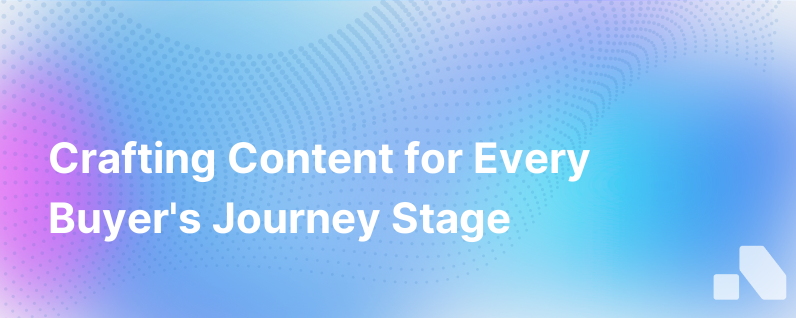
Creating content aligned with each stage of the buyer’s journey is pivotal in fostering customer relationships, nurturing leads effectively, and driving conversions. Misaligned content can lead to a disengaged audience and low conversion rates as it may fail to address the buyer's needs at specific stages. Here, we’ll dissect the buyer's journey into discrete stages—Awareness, Consideration, and Decision—unveiling strategies and content types that resonate at each juncture.
Understanding the Buyer’s Journey
Before we delve into content creation, it’s pertinent to grasp the psychological underpinnings of the buyer’s journey. This odyssey begins the moment a buyer becomes aware of a pain point and traverses through the evaluation of solutions, culminating in a purchase decision.
- Awareness Stage: The onset of a journey, this is when potential buyers identify a problem or opportunity. They’re seeking educational content to better understand their situation.
- Consideration Stage: Buyers know their problem and seek out options. Here, they're comparing solutions, looking for deeper, more evaluative content.
- Decision Stage: The buyer has chosen a solution strategy and is looking for practical steps to implement it. They need content that reassures and guides them towards making a purchase.
Content Creation for the Awareness Stage
During this stage, prospects are not yet ready to buy. They are hunting for information to understand and frame their problem. The content should be educational, answering basic questions and illuminating insights related to their challenges.
Types of Content:
- Blog Posts: Share industry trends, best practices, or common challenges that resonate with the audience’s pain points.
- E-books and Whitepapers: Offer expansive insights on specific topics to build trust and credibility.
- Infographics: Present statistics, trends, or concepts in a visually engaging format to grab attention and provide value quickly.
- Social Media Posts: Create bite-sized pieces of content that inform and engage users on platforms where they spend their time.
- Videos: Develop informative video content explaining the problems your target audience faces in an engaging, easy-to-consume format.
Content Creation for the Consideration Stage
At this juncture, your prospective buyers are evaluating different methods to remedy their problem. Content should compare different solutions, showcasing how your offering aligns with their needs better than others.
Types of Content:
- Webinars: Host interactive sessions where experts discuss solutions and answer questions live, conveying thought leadership.
- Case Studies: Showcase success stories of customers who faced similar challenges and how they overcame them with your solution.
- Comparison Guides: Compare various solutions, highlighting the unique benefits and differentiators of your offering.
- Product Demonstration Videos: Create demonstrations showcasing the capabilities and benefits of your solution.
- FAQs: Compile questions typical buyers consider during this stage and provide clear, concise answers.
Content Creation for the Decision Stage
The decision stage is where buyers choose a particular solution; often, they're shortlisting vendors and products. Here, content needs to be persuasive and detailed, providing the final nudge towards conversion.
Types of Content:
- Free Trials or Product Samples: Allow buyers to experience your solution firsthand, removing barriers to purchase.
- Live Demos: Schedule personalized demonstrations to walk potential customers through your product, highlighting functionality that aligns with their needs.
- Spec Sheets and Product Comparison Charts: Offer detailed views of product specifics that enable buyers to discern subtleties between options.
- Customer Testimonials and Reviews: Leverage social proof to build trust and reduce purchase anxiety.
- Checklists and Buying Guides: Equip buyers with the tools to make informed decisions and understand the purchase process.
Tailoring Content by Buyer Persona
Understanding the buyer persona is critical for content alignment. Different buyer personas may have varying challenges, goals, and pain points even within the same stage. Hence, persona-specific content creation becomes necessary to truly resonate and engage each segment of your audience.
Persona-based Strategies:
- Segmentation: Develop content aimed at industry verticals, roles, or company sizes to hit specific notes that reverberate with each persona.
- Personalization: Tailor content at the individual level when possible, using data-driven insights to cater messages and solutions to a persona’s specific context.
- User-Generated Content: Encourage and share content created by users that align with your persona profiles, bolstering community engagement and trust.
Leveraging Data-Driven Insights
Utilize analytics to understand which content types and topics are resonating. Look at which pieces are driving traffic, engagement, and conversions. This data should inform your content strategy and enable you to fine-tune your approach continually.
Data Considerations:
- Content Performance Metrics: Use engagement metrics, such as time on page and bounce rate, to ascertain the relevance and quality of your content.
- Conversion Tracking: Monitor which content pieces lead to conversions and sales, refining your strategy to duplicate successful tactics.
- Buyer Feedback: Collect direct feedback through surveys or customer interviews to better understand the content's impact on their journey.
Conclusion
Crafting the right content for each stage of the buyer's journey is both an art and a science. By understanding the nuances of each stage and aligning strategy with persona-specific needs, you can ensure that your content not only attracts but also nurtures and converts potential customers into loyal advocates.
For those leveraging platforms like Aomni, this process is seamlessly integrated into your sales strategy. With real-time insights, personalized content recommendations, and comprehensive analytics, Aomni helps you deliver targeted content at scale, ensuring that every piece resonates with your buyer's journey and aligns with their evolving needs.